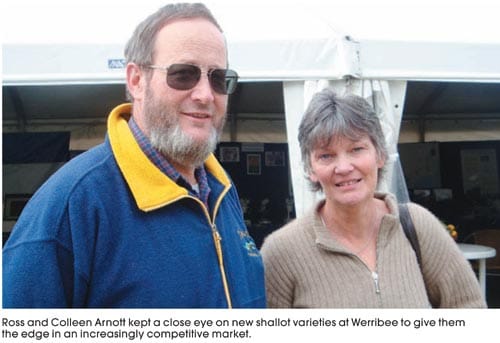|
|
FROM planting their first trial 12 years ago, Ross and Colleen Arnott have become the largest shallot producers in Australia. Their nine-hectare crop at Boneo on Victoria’s Mornington Peninsula includes six varieties and perhaps soon a seventh if a new, earlier variety at the expo takes their fancy. Mr Arnott said in the past decade there had been a steady rise in demand for shallots as popularity of the vegetable increased, but that had started to plateau recently. “When the global financial crisis hit, our top end of the market, like restaurants, slowed up buying,” he said. “They are one of our largest users of shallots. Restaurants use them in their French sauces.”
Mr Arnott has been growing vegetables for nearly 30 years, with carrots previously his main crop on a property that’s been in the family since the 1850s. “But they went the way of onions and potatoes – high acreage, high volume and low margins – so we diversified with the shallots more than a decade ago,” he said. “When we first started they were only imports and a few of the old-style shallots where you planted the bulb and they multiplied themselves. One of the good things about making the switch to seed is that you don’t have to worry about saving the bulbs for next year.” Mr Arnott conceded seed was more expensive, but it paid off with higher yields. “Plus we don’t need as much labour because only one person is needed on the seeder,” Mrs Arnott said. The Arnotts supply shallots Australia-wide, but Mr Arnott said this hadn’t eased overseas competition. “International growers are subsidised a bit out of Europe and there are rumours of shallots being grown in China,” he said. “The only advantage we’ll have in this case is that our shallots will be grown in opposite seasons. “So when their stuff’s getting a bit old, ours will be new season. We’re one of only a few shallot growers around the area and supplying the demand that’s out there. “It would be very easy to overdo the market. However, there’s still a need for us to plant more of certain varieties that we haven’t got enough of this year, I’d say. And no, I’m not telling you which ones!” The Arnott family is also supplying 60% of the Melbourne long white radish (daikon) market. Eight years ago, the first white radish seeds went in and now there’s a flourishing 18ha crop. “We were exporting white radish to Taiwan, but that stopped after a few years when the Australian dollar went up. It was not economic for them to import our radish, but the domestic market was better anyway. “We took our seconds into the market and found they were better than others first grade product”, Mr Arnott said.. If I knew all my secrets, I’d patent them – but I don’t! We’re doing something right anyway.” White radish needs a lot of water to grow, so Mrs Arnott said many growers were probably considering getting out to try to conserve more water. “We’re fortunate our water comes from underground and we’ve got recycled water coming on from this year, so we’re totally drought proof,” she said. Source: GOOD FRUIT & VEGETABLES – June 2009 (pdf 177k) |
|
